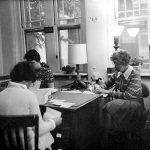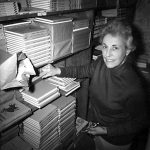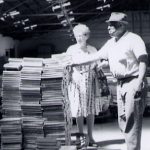The History of International Book Project
by Angene Wilson – Past President and Board Member, IBP Board of Directors
Harriet Van Meter traveled to India in 1965 with a group of foreign student advisors, saw a need for books, and knew books were linked to education. After she returned home to Lexington, Kentucky she wrote a letter to the Editor of the Hindu Times and offered to send books to anyone who would write her. Within weeks, she had received 400 letters. So her home on Mentelle Park became a center for collecting, storing, and packaging books for shipment first to families, and then schools, colleges, and libraries who requested them from India, and as word spread, from countries all over the world.
In its early decades, the International Book Project also served as a clearinghouse for requests, encouraging individuals and groups beyond Lexington to send books. An individual could become a member for $10 a year and receive a monthly newsletter. The earliest extant copy of the newsletter What’s New, dated February 1972, pleaded for participating volunteers to send the founder information on “the blue cards” about their shipments. Presciently, Mrs. Van Meter wrote: “We will never get money to become more efficient (this would be a perfect home for a computer) unless we can tell foundations (the ones which might give us money) what is being done by YOU.” She developed a numerical system for foreign files: for example, 145B asked for current journals in surgical gynecology and 1034, 763B, and 46B requested books in French. The newsletter Can You Help department sometimes listed specific requests by country: methane gas production (India), water resources planning (Iraq), marine biology (Tonga), park management (Ghana). In 1980 the Can You Help department included a request from China for multiple copies of novels such as Lord of the Flies and Grapes of Wrath, “but avoid sex, violence, and anti-communism.”
The response was impressive. Total figures for 1972 were “56,548 books sent (how many not reported?) by Volunteers throughout the USA, Canada, Australia, and Europe and 47,857 more sent from the IBP workroom by Volunteers and Staff.” Under the heading, “They Get the Job Done,” in the October 1972 What’s New, Jacqueline Rubin of Oak Park, Michigan wrote: “We have shipped 190 elementary texts to British Honduras (our second shipment), 19 packages to Monrovia. We send them in sets of at least 25 so an entire class may use them. The Oak Park Kiwanis is contributing $25 a month, indefinitely until all have been sent. We estimate there are about 5000 books to be sent.” Often churches participated, and once the newsletter included a sample paragraph for a church bulletin board. Zion Lutheran Church in Akron, Ohio sent books to India, Kenya, Fiji, and the Philippines in the early 1970s and in 1975 met IBP’s challenge to ship 20,000 books to Indonesia. In 1976 12% of books shipped went to families, 38% to schools, 12% to colleges, and 36% to libraries.
By the early the 1970s each newsletter stated IBP’s goal as: “People like to help themselves and are eager for books and technical publications that tell how to raise better cattle, poultry, vegetables, fish, bees; to build better schools, roads, dams, hospitals, businesses; to install plumbing, electricity; to repair cars, radios, machinery. . . If you have books to re-cycle through their minds, IBP will tell you where and how to send them directly to those who will use them.” By 1988 and through the 1990s and early 2000s the stated goals broadened: “Through providing quality, needed books to the peoples of the world, IBP seeks: to help others help themselves, to broaden American’s understanding of their neighbors, and to foster global friendships and strengthen world unity.” Still sending needed books was basic.
Tom Zemsky, who began working with Harriet Van Meter in her basement in 1976 and retired in 2009 after decades as a warehouse manager, described the system of sending books from Mentelle Park. “Books were sorted and selected according to their condition, subject, and appropriate English level. They were then wrapped in up to 10 lb bundles, using brown butcher paper, string, and glue; address labels run off a copier and applied; packed up to 30 to 35 lbs in a canvas mailbag, an outer destination tag tied on that, the bags bundled into a car and taken behind the main post office where they were individually weighed and postage applied.” When IBP began to send pallets and even sea containers, the organization borrowed warehouse space, for example, tobacco warehouses in the offseason. In 1980 a building that belonged to the Third Street YMCA was converted into a warehouse and used by IBP rent-free until October 1983. Then the board decided it was time for a permanent location, and the current building on Delaware Avenue was purchased. Over the years Improvements were made to the offices and warehouse, and an in-house bookstore was created in the 2000s.
Finances were a perennial issue for IBP. The May 1976 What’s New reported checks from the Gregg Foundation and Philip Morris International, but memorials, memberships, donations and nearly $10,000 from the 1975 International Festival that IBP organized still did not meet the $35,000 budget and a staff member was let go. In 1976 the newsletter noted a $2000 contribution from a U.S. Army nurse and doctor in Germany. Donations in 1978 were “at lowest ebb in years,” but IBP received its first bequest of $2000 for the Perpetuation Fund. IBP sold sandalwood soap from India, one year Christmas Philippine crosses, and another year Samran bronzeware from Thailand, as well as joy cards for Christmas (500 sent in 1982) and friendship cards for other occasions. A Minerva, Ohio woman collected coupons and trading stamps and advertised for them regularly in the newsletter. IBP sent a penny pot to whoever requested one; it was accompanied by the following rhyme: “It takes coins to send books, and books to fill minds. The Leprechaun’s pot holds coins of all kinds. Let your change change the world.”
By mid-1981 the newsletter reported that since IBP’s founding “despite disappointment, tripled postage costs, insufficient staff, Volunteers have furnished considerably more than 1, 500,000 books and journals to people eager for education, inspiration, and friendship.” However, the YMCA warehouse contained more than 100,000 books “waiting for SOMEONE to send shipping funds.” Besides higher postage rates, IBP at that time was concerned about the discount to nonprofit mailers being discontinued. In 1982 the newsletter reported IBP was “going in the red at $2000 a month.” An article about IBP in Guidepost magazine in 1984 did result in many Bibles being sent to Lexington and also money, including a $500 bill. A fund-raising letter in 1986 netted $15,500 which was used to send” 49,000 books to 304 organizations in 45 countries.” In 2000 a challenge grant of $10,000 aimed to raise another $10,000 to send books to the Philippines and to Eastern Europe and Estonia, Latvia, and Lithuania and raised $15,444. Also in 2000, IBP launched its first Annual Appeal to raise $90,000 but faced with terrorism and the economic downturn after September 11, 2001, IBP had to cut both staff and marketing. Still, IBP sent large shipments to Pakistan and fulfilled its 2002 Books for Children and Libraries Challenge with help from the Medina Foundation and McGraw Hill. No records exist for 2003 and 2004. In 2005 165,000 books were shipped in 132 M-bags and nine sea containers to 49 countries. The goal for IBP’s 40th anniversary in 2006 was 200,000 books and 210,928 books were sent. Sending books was complicated by the U.S. Post Office discontinuing M-bags and international surface shipping in 2007, though by that time IBP was shipping more pallets and sea containers. In 2012 IBP developed a new application process focusing more on larger shipments. In the years 2009 through 2015 more than 200,000 books were shipped each year, with 287,212 shipped in 2015.
Throughout its history, IBP has stretched resources by working with various groups and getting grants from foundations. For some years the International Exchange Service at the Smithsonian forwarded 200 pounds of books a month to help IBP send medical journals to universities in Afghanistan, Argentina, Bangladesh, Iran, and Pakistan; their service ended in 1994. The May 1978 What’s New thanked “Rotary, Lions, Kiwanis, AAW, Vet Auxiliaries, Medical Auxiliaries, Beta Clubs, Girls Scouts, Jaycees, Junior Women’s Clubs, Libraries, Colleges, and schools. . . so many, each doing what that group can.” The October-November 1983 What’s New thanked Kiwanis International, Uniroyal, Bethlehem Steel, Oliver Trucking, and Central District Tobacco Warehouse for helping send $300,000 worth of school and college books to Liberia which Peace Corps Volunteers there sorted and distributed. In 2000 a sea container of 23,000 books was sent to Thailand with support from Rotary. In 1984 the Knight-Ridder Foundation donated a badly needed computer. In 2005 a gift from the Virginia Clark Hagan Charitable Foundation allowed IBP to develop a website, and that foundation has continued to support IBP. In 2006 and 2007 IBP teamed up with Starbucks for a Holiday book drive. In 2006 IBP listed as partners the Brother’s Brother Foundation, the Million Dollar Round Table Foundation, and the American Founders Bank. In 2008 McGraw Hill donated 18,000 primary texts in Spanish to go to Ecuador. In spring 2013 IBP partnered with Dr. Viji, a Lexington resident and president of the We Serve Foundation, to send books to centers in rural India.
Peace Corps is one of the organizations with which IBP has had the longest relationship; Listed as a source for books in Peace Corps materials, IBP received regular requests from Volunteers. In a typical year, about 20% of small shipments have gone to Peace Corps Volunteers. For a time, the Peace Corps Washington Office paid for the shipping costs to African countries, and in 1992 IBP was recognized by the Peace Corps as one of its 20 Partners for Peace. In that first extant February 1972 newsletter, a Kenya Volunteer described her school’s “undernourished, atrophied library” and her students who have “an incredible thirst for reading.” In the April 1977 What’s New, a Jamaica Volunteer asked for posters, picture books, story books, magazines with colored pictures for her preschool teacher training program that would benefit 96 schools and 3000 children. The May 1980 What’s New saluted the Peace Corps, saying in a long headline that “International Book Project Volunteers Make It Possible for Peace Corps Volunteers in Many Countries to be More Effective” and excerpting letters from Volunteers in Central African Republic, Chad, Fiji, Philippines, and Upper Volta (now Burkina Faso).
Brandenburg, Kentucky native Jane Marlow Willis, a Peace Corps Volunteer in the Solomons, wrote the lead article in the renamed spring 1989 Books Abroad newsletter recognizing New Jersey and Idaho volunteers who had provided children and adult books and encyclopedias for the Agagana School on Rendova Island; the last leg of the books’ journey was by canoe. That same year, a Kenya Volunteer wrote that the books sent “fit our programs perfectly. It is almost as if you came here personally to see what we need.” And another Volunteer wrote “The books have been an incredible success!! The world is opening up in far western Nepal.” Recognizing Peace Corps’ 40th anniversary, IBP’s challenge grant of 2001 focused on responding to requests for books from Peace Corps Volunteers in 34 countries, from Armenia to Zimbabwe. In fall 2009 a Peace Corps volunteer’s mobile library in Nicaragua was the front page newsletter article. The spring 2010 newsletter told the story of Returned Peace Corps Volunteer (RPCV) Harry Siler who served in the early 2000s in South Africa and seven years later organized a sea container to send to support five village primary schools in South Africa’s poorest province. The Spring 2011 newsletter highlighted Peace Corps’ 50th anniversary and included responses from PCVs in the Dominican Republic, Macedonia, Mozambique, and Paraguay. The Macedonia PCV reported that the English teachers were excited about the possibilities of enriching their classes. The Paraguay Volunteer received Spanish children’s books for his Reading Club. The requests continue. In March 2016 PCV Jessica, serving in the Philippines on the island of Siquijor, emailed IBP to ask for books for a library for Lazi National Agricultural School. And in 2016 the President of the board of IBP is a RPCV and two current and two recent board members are also RPCVs.
Connections between individuals and IBP have often been long-lasting. Wrote a recipient of books in the Philippines in 1987, “My relationship with IBP goes back a long way to 1978 when your marvelous volunteers literally saved my Peace Corps experience in Western Samoa with a ‘fast fix’ of 500 books. I’ve been hooked on your organization ever since.” Over several decades Victor Childers, a faculty member at Indiana University’s Kelley School of Business, routinely collected business and economics books for IBP. Retired, in 2004 he hauled books to Lexington in a rented SUV and borrowed van; 20 years earlier he had sent a shipment of books to IBP via a commercial truck line with Indiana University absorbing the cost. In 2009 Susan Ishmael, living in Texas but originally from Kentucky, found IBP could be the way to send books for a library’s worth of books to children she had met in Ghana; since then she has funded three other libraries in other countries and joined IBP’s Board. In 2010 Albanian Ridvan Pshkopia, a UK Ph.D. graduate, worked with the American University of Tirana to fund a sea container which IBP filled with textbooks; their relationship with IBP continues.
IBP has always depended heavily on inspired volunteers. Anne Caudill, who was one of the regular volunteers from 1976 to 1984 when her husband Harry Caudill was teaching in the University of Kentucky’s History Department, recalled how she enjoyed her work, “which consisted largely of correspondence with donors of funds and books and with requests and thank you letters from recipients. Their responses were touching and heartening.” Recipient responses appeared regularly in the 1970s and 1980s newsletters, as well as letters by volunteers about the responses. Wrote a recipient from Sarawak in 1977, “It is obvious that someone consulted the note I sent last year since the books match closely my ‘wish list.’ One of the biology books alone was worth making the shipment.” A sender, Mrs. Ward of Ontario, Canada wrote in 1973: “Some of my greatest pleasures are looking forward to the correspondence of my people in Ceylon, Malaysia, and India. Thanks to IBP, I am gaining far more than I am giving.” Sometimes individuals started small. In fall 2012 Paige Hendrickson, a librarian in Tennessee placed empty boxes outside her door to collect books for IBP and when a high school added textbooks she realized she had to rent a U-Haul to bring 3,000 books in 188 boxes to Lexington. Allison Harnish who did her doctoral dissertation research in Zambia began by delivering school supplies to one school in Zambia with the help of a Fayette County elementary school and a church and then worked with Transylvania University students to two more schools in Zambia.
Super volunteers Terry and Harry Bailey served as office managers at IBP in the late 1980s; when Harry Bailey, a retired agronomy professor at the University of Kentucky, died in 1990 65 individuals and couples made memorial gifts to IBP in his name. The fall 2012 newsletter noted that two student volunteers had taken on the challenge of funding and shipping large shipments to Kenya and Uganda. And volunteers were always needed for sorting and packing. The spring 2012 newsletter featured pictures of the Frankfort-Lexington Association of Ghanaians and the Young Adults of Unitarian-Universalist Church. Many individuals have volunteered on the Board of IBP over the years as well, giving both time and money.
Of course, for the first 20 years, she served as Executive Director, founder Harriet Van Meter was the most important volunteer. After turning over that job to Will Weatherford in January 1986, she was honored at the May annual meeting. That same year she was nominated for the Nobel Peace Prize and placed among the eight final nominees. In 1989 she received the Kiwanis World Service Medal. For a number of years after her death in 1997, IBP gave annual Harriet Van Meter Humanitarian Awards for International Relations, appropriate since Mrs. Van Meter always saw IBP in the larger picture of international education. For three years 1975, 1976, 1977 she led the organization of an International Festival at University of Kentucky’s Memorial Coliseum. In 1974 she floated the idea of a seminar in India in a newsletter. In 1978 she offered to take IBP volunteers with her on a 1979 trip to the Philippines where a memorial library was named in her honor. In 1980 she tried out the idea of a” non-convention;” the day-long event at Spindletop Hall featured discussions on “New Asia, New Africa and New World” with speakers from Brazil, Ghana, Guyana, India, and Nigeria and the University of Kentucky. Later IBP sponsored a book fair by various names; in 1998 the 11th fair raised $13,000 and drew 1000 people at Heritage Hall in downtown Lexington.
Although Mrs. Van Meter explained in the March April 1979 newsletter why IBP did not send books to Appalachian schools (school boards, bookmobiles, the state, and foundations provided books for those schools), by 2000 the purpose of sending books had been changed from “helping others help themselves” to promoting “education and literacy in developing countries and in areas of need in the United States.” Although the front page newsletter articles usually highlighted international projects, including sending containers to Uganda, Ghana, and Tanzania to celebrate IBP’s 40th anniversary in 2006 and sending a sea container of university books to Afghanistan in 2008, the spring 2012 newsletter explained how IBP changed lives in eastern and central Kentucky by working with the Whitley County Public Library, by partnering with Teach for American Appalachia, by working with the local mentoring program Amachi, and by giving new owners of Habitat for Humanity homes a bookcase of books. In 2013 IBP partnered with Lexington’s Read to Succeed initiative in low-income neighborhoods. In 2015 IBP sent its first donation of books to a prison, Luther Luckett Correctional Complex in Oldham County.
In 2008 IBP inaugurated a new literacy program entitled Books as Bridges that aimed to link students and schools in Kentucky with students and schools in other countries. That program made the front page of newsletters in 2008, 2010, 2011, and 2014. As it developed beyond a pen pal exchange, a stipend was added for overseas partners so they could send letters and “culture packages.” In fall 2010 the newsletter advertised Weird and Wonderful, a Books as Bridges Cultural Event at the Explorium in Lexington “for students, families, and teachers who celebrate world cultures and to recognize students who completed a service project (often sending books) for their overseas pen pals.” Also in 2010 Coordinator Tracy Nearhoof, who was also a member of Kentucky Ecuador Partners, received a grant from Partners of the Americas to take suitcases of books and classroom supplies to Ecuador and visit partner schools there. In that year 1,507 students in Kentucky were partnered with eight classes in Ecuador and 52 other classrooms in nine countries. In 2011 she and Executive Director Rachel Lewis visited Books as Bridges partner schools in Ghana and began to think about how technology, especially using cell phones, could help the international communication between schools and foster that global friendship mentioned in the broadened IBP goals.
In its 50th year IBP has clarified its core mission: “to promote literacy, International Book Project responds to requests for books around the world.” In a very different world from 1966, the organization in 2016 still believes that books are crucial for literacy that will empower individuals and communities. As Mrs. Van Meter saw in 1966, sending needed books is the central point of IBP. What has happened to people because of that mission and those now more than 6.8 million books is in many ways still an only half-told story.
This brief history of IBP was written in 2016 by the current board president and occasional IBP participant since 1975 Angene Wilson, using as resources mostly the fascinating treasure trove of newsletters of the organization, and also short remembrances written by Tom Zemsky and Anne Caudill and conversations with various other people.
Since 2016, IBP has embarked upon a new chapter. A newly renovated warehouse and public space are increasing shipping efficiencies and allowing IBP to become more involved with our local community. We now have a monthly book club, host outside events and meetings, and enjoy an expanded and more visible bookstore. Volunteer numbers have skyrocketed and we have exceeded the 7 million books shipped mark!
More on Harriet – watch this documentary produced in 2006 by Arthur Rouse and Kiley Lane Parker…





